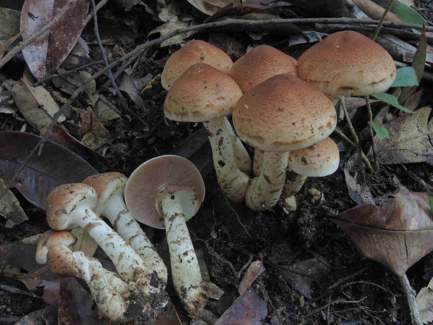 Hebeloma parvisporum (Photo: T. Læssøe)
Hebeloma parvisporum (Photo: T. Læssøe)Taxonomy
Full name: Hebeloma parvisporum Sparre Pedersen, Læssøe, Beker & U. Eberh., Mycologia 112: 179 (2020)Genus: Hebeloma
Section: Porphyrospora
Types: LAOS: Xieng Khouang, Laethong, Phoukhout (19.7424°N, 103.2581°E, alt. approx. 1135 m a.s.l.) in montane, tropical woodland under Castanopsis sp., Fagus sp. and Lithocarpus sp., 18 Aug. 2015, T. Læssøe, O. Pedersen (Holotype. herbarium acc. no. HNL 500968, HJB14852).
Heterotypic synonyms:
- Psathyrella splendens Corner, Gardens Bulletin Singapore 45 (2): 341 (1994) ["1993"]
- Lacrymaria splendens Voto, Rivista Micologica Romana, Bolletino dell'Associazione Micologica Ecologica Romana 107: 95 (2019)
- Lacrymaria splendens S.M.L. Lee & Voto, Rivista Micologica Romana, Boll. AMER 110 (2): 90 (2020)
- arrow_drop_downarrow_drop_upEtymologyparvisporum (Latin), in reference to the small spores.
- arrow_drop_downarrow_drop_upDiagnosisDiffers from all phylogenetically confirmed species of the genus by the small size of the spores and the low spore Q value.
References
Description
- arrow_drop_downarrow_drop_upThresholds
Description of Hebeloma parvisporum based on 9 collections
- arrow_drop_downarrow_drop_upMacroscopic descriptionPileus: (40) 73–118 (150) mm diameter; shape occasionally convex, none or umbonate; characters often remains of universal veil or spotting, occasionally scaly; margin characters often involute, occasionally smooth; viscosity tacky when moist; colour variation two color; colour at centre orange-brown.
Lamellae: attachment adnate or decurrent tooth, often emarginate; maximum depth up to 8 mm; number of complete lamellae 76–85; presence of tears visible with x10 lens; white fimbriate edge often very strong, occasionally present.
Cortina presence: yes.
Stipe: (70) 80–152 (180) x (5) 9–28 (30) {median} x (6) 15–19 (25) {basal} mm; stipe Q 5.2–14.0; base shape often bulbous, occasionally tapering; floccosity often floccose or pruinose at apex, occasionally fibrillose or transverse; rooting often yes, occasionally no; thick rhizoids at base absent;
Context: Texture firm; stipe interior hollow; stipe flesh discolouring often no, occasionally yes; slenderness measure 6.7–15.8; smell occasionally odourless; taste bitter where recorded.
Spore deposit colour: Not recorded.
Exsiccata characters: often lamellae blackening or pileus blackening.
- arrow_drop_downarrow_drop_upMicroscopic descriptionSpores: shape amygdaloid or ellipsoid; colour in microscope often yellow brown, occasionally brown; guttules variable. papilla no; Spore Code: O3 O4; P3; (D2) D3.
Basidia: (15) 16–29 x 5–8 (9) μm; ave. Q 2.8–3.7; spore arrangement 4 spored;
Cheilocystidia: main shape clavate-stipitate, often capitate-stipitate, occasionally spathulate-stipitate, rarely gently clavate; special features observed occasionally apical thickening, rarely many collapsed in exsiccata or septa; cheilocystidia ratios: A/M = 1.80–3.28; A/B = 2.08–3.27; B/M = 0.74–1.16.
Pleurocystidia: often none seen, occasionally seen.
Ixocutis: epicutis thickness (measured from exsiccata) up to 10 μm; ixocutis hyphae width not recorded; ixocutis hyphae encrustation yes; shape of trama elements beneath subcutis cylindrical, ellipsoid or thinly sausage-shaped up to 12 μm wide.
Caulocystidia: Similar to cheilocystidia but larger, up to 80 μm.
- arrow_drop_downarrow_drop_upSpore measurements
- arrow_drop_downarrow_drop_upCheilocystidia measurements
- arrow_drop_downarrow_drop_upHabitat and distributionHebeloma parvisporum's preferred habitat appears to be mixed, tropical woodland or tropical woodland with soil and litter or soil. Where only one possible associate was recorded, that associate has always been Dipterocarpus (family Dipterocarpaceae). We have additional records where Fagus, Lithocarpus, Castanopsis, Pinus and Keteleeria were recorded as possible associates, but in these cases a number of possible associates were mentioned. Overall the most commonly recorded families are Fagaceae (66.7%), Dipterocarpaceae (33.3%) and Pinaceae (33.3%) The growth habit of our collections was caespitose and often gregarious or solitary.
According to our current collections, the species is found only in Asia-Tropical. On the continent, collections have been found only in the tropical & subtropical moist broadleaf forests WWF biome The World Wildlife Fund (WWF) have divided the world into 867 terrestrial ecoregions. The ecoregion here is estimated by mapping from the GPS coordinates of the collection using data made available by Dinerstein et al (2017). Use this webtool to explore the ecoregions visually or see a full list of current ecoregions on Wikipedia. (Luang Prabang montane rain forests (62.5%) and Peninsular Malaysian rain forests (37.5%) ecoregions). From collector information, it appears collections have been found in the 1.9 Forest – Subtropical/tropical moist montane (62.5%) and 1.5 Forest – Subtropical/tropical dry (37.5%) IUCN habitats We map from the collector's description of the habitat to the International Union for Conservation of Nature (IUCN)'s definition using a standardised set of rules. Please see this page for a full list of IUCN habitats.. Within Tropical Asia we have records from Indo-china (Laos) and Malesia (Singapore and Malaysia).
- arrow_drop_downarrow_drop_upCommentaryHebeloma parvisporum is currently only known from Laos. It was depicted and discussed under the name H. aff. victoriense in Læssøe et al. (2019). The small, strongly ornamented, warty spores with Q value less than 1.30 and with strongly loosening perispores are sufficient, microscopically, to distinguish this species from other species of Hebeloma that we have encountered. The capitate-, clavate-, or spathulate-stipitate cheilocystidia are reminiscent of H. subsect. Crustuliniformia of H. sect. Denudata. Macroscopically, this species is very distinctive and reminiscent of H. victoriense but is smaller, less robust, and more slender. At the time of publication of this species we were not aware that the species has been described before as Psathyrella splendeds Corner (1993). Had we been aware of Psathyrella splendens, we would have used that epithet for H. parvisporum. When describing the species, other genera like Alnicola, Naucoria, and even Pholiota were checked for misplaced Hebeloma species (Eberhardt et al. 2020), but it did not occur to us to investigate Psathyrella names. In the diagnosis, the restriction to phylogenetically confirmed species of Hebeloma was made, because a number of species that have been described as Hebeloma have smaller spores than H. parvisporum. These taxa have since been shown not to belong to the genus (e.g., Beker et al. 2016), but not all of these species have been transferred to other genera yet. This also applies to H. microsporum (Eberhardt et al. 2018).
Geographic distribution
Phenology
- arrow_drop_downarrow_drop_upAdditional cited collections